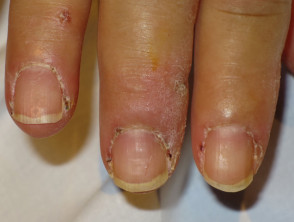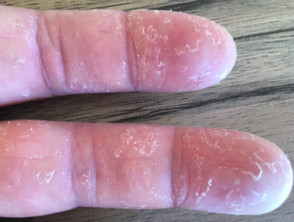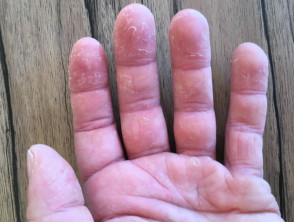What is antisynthetase syndrome?
Antisynthetase syndrome is a rare inflammatory muscle disease related to dermatomyositis and polymyositis.
The hallmark of antisynthetase syndrome is the presence of serum autoantibodies directed against aminoacyl-tRNA synthetases. These are cellular enzymes involved in protein synthesis. Antisynthetase antibodies include Jo-1, PL-7, PL-12, OJ, EJ, KS, Wa, YRS, and Zo. Anti-Jo-1 antibodies are the most commonly detected in antisynthetase syndrome.
Antisynthetase syndrome is 2–3 times more common in women than in men.
What causes antisynthetase syndrome?
The cause of antisynthetase syndrome is unknown. It is classified as a chronic autoimmune disease.
How does antisynthetase syndrome present?
The main clinical features of antisynthetase syndrome are:
- Fever
- Myositis (muscle inflammation)
- Polyarthritis (inflammation in several joints)
- Interstitial lung disease (non-specific inflammation of the lungs)
- Mechanic’s hands
- Raynaud phenomenon
Antisynthetase syndrome can present with a variety of clinical features and these may vary over time.
Fever
- Present in about 20% of patients
- May occur at onset of disease
- May persist or recur with relapses
Myositis
- Present in >90% of patients
- Associated with anti Jo-1 antibodies
- Proximal muscle weakness causes difficulty getting up from a chair or climbing stairs
- Muscles may be painful
- Weakness of the muscles involved in swallowing can result in aspiration pneumonia.
- Weakness of the muscles of respiration can result in shortness of breath
Inflammatory arthritis
- 50% of patients experience joint pains or arthritis
- Most often symmetrical arthritis of small joints of hands and feet
- Typically, does not result in bony erosions
Lung disease
- Interstitial lung disease develops in most patients with anti- Jo-1 antisynthetase syndrome
- Often presents with sudden or gradual onset of shortness of breath on exertion
- Sometimes causes intractable dry cough
- May lead to pulmonary hypertension (increased pressure in pulmonary arteries) in patients with or without concomitant interstitial lung disease.
Mechanic’s hands
- Affects about 30% of patients
- Thickened skin of tips and margins of the fingers
- Resembles a mechanic’s hands
Raynaud phenomenon
- Occurs in about 40% of patients
- An episodic reduction in blood supply of fingers or toes which turn white, then blue and finally red
- A response to cold or emotional stress
- Some patients have associated nail fold capillary abnormalities
Symptoms of antisynthetase syndrome
Antisynthetase syndrome
Association with malignancy
Some case studies have reported various malignancies occurring within 6–12 months of the diagnosis of antisynthetase syndrome. Age-appropriate screening is therefore recommended, as for dermatomyositis.
How is the diagnosis of antisynthetase syndrome made?
The clinical presentation is a clue to the diagnosis of antisynthetase syndrome. Special investigations help to support the diagnosis. These may include the following depending on the clinical context:
- Muscle enzymes eg creatinine kinase (CK) and aldolase: these are often elevated
- Muscle antibodies
- Electromyography (EMG)
- Magnetic resonance imaging (MRI) of affected muscles
- Muscle biopsy
- Lung function tests
- High resolution computed tomography scan (CT) of the chest
- Evaluation of swallowing difficulties and aspiration risk
- Lung biopsy
How is antisynthetase syndrome treated?
Glucocorticosteroids are the mainstay of treatment for antisynthetase syndrome and are often required for several months or years. Prednisone is initially given at high doses (1 mg/kg/day) for 4–6 weeks to achieve disease control, then tapered slowly over 9–12 months to the lowest effective dose to maintain remission. In more severe cases, pulsed intravenous (IV) methylprednisolone for 3–5 days may be necessary.
Improvement in muscle strength can take several weeks or months. Symptomatic improvement is a more reliable indicator of response to treatment than serum CK levels.
Prophylactic treatment is recommended against steroid-induced osteoporosis and certain fungus infections such as Pneumocystis jirovecii. Need for immunisations should be assessed prior to commencing therapy.
Other immunosuppressive medications may be used, such as:
Physical therapy and rehabilitation should start early to prevent muscle deconditioning and to improve weakness.
Prognosis of antisynthetase syndrome
Patients with antisynthetase syndrome respond well to systemic steroids and/or immunosuppressive agents if they only have muscle involvement.
If lungs are involved, the severity and type of lung injury determine the prognosis. Older age at onset (>60 years), presence of malignancy, and negative ANA antibody test confer a worse prognosis.


